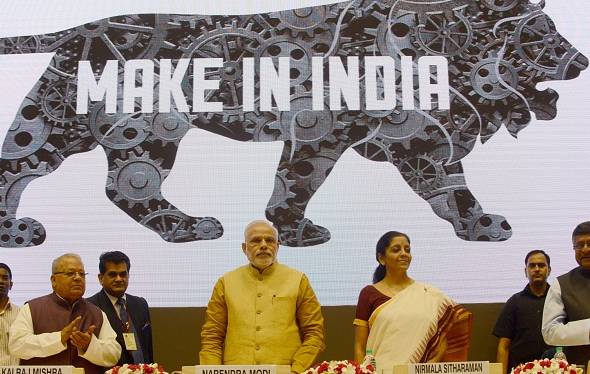
Bo Bennett, an American businessman, once said: “As sure as the spring will follow the winter, prosperity and economic growth will follow recession.” For India, this is an interesting point to consider. To sustain high growth in future, it must pay close attention to a complex web of interconnected factors such as appreciating U.S. dollar, falling crude oil prices, a slowing China, a restless exchange rate, and exports. The growth of the manufacturing sector is a case in point.
During the last 19 months, Narendra Modi’s government has worked towards improving ease of doing business in India, while pushing for aggressive resource expansion within the manufacturing sector. This is best evidenced by the Make in India program. Being part of this fourth Industrial Revolution seems right for India as it increases its share in the global manufacturing production pie. However, for this policy vision to be a success, it is critical that policymakers are aware of the potential opportunities and challenges brought about by some external and internal economic factors.
External factors: Trade, Currency games, and more
Figure 1: India’s Bilateral Trade with the United States

Source: Author’s calculations from Export-Import database (Ministry of Commerce, India)
The increasing trend of trade balance between India and the United States has been a positive sign for India’s export market over the last three to four years (see figure 1).
Figure 2: Currency Trends (U.S. Dollar vs. Indian Rupee)

Source: Author’s calculations from Trading Economics
The Indian rupee (since 2014) has been weakening against an appreciating U.S. dollar (see figure 2), which has allowed the Indian export basket to become cheaper and rise in the American market. A weakened rupee (if it does not depreciate or fall in value further) will make India a cheaper destination for investment, thereby potentially attracting more money from American and other investors from the West. However, a gradual increase in short-term real interest rates from the Federal Reserve is also likely to make the United States a more profitable investment destination. This will negatively impact FDI in India, adversely affecting the Make in India plan in particular.
Provided the Reserve Bank of India (RBI) can successfully maintain the rupee’s current value, India will seek more foreign investment from developed economies. However, such calculated impact analysis of macro-investment decisions assumes ceteris paribus (i.e., all other things being equal). This may not be prudent in understanding the subtleties of a real economy. Factors such as domestic political stability, currency valuations, real interest rates, global commodity prices (especially the role of falling oil prices), aggregate export demand, and level of inflation play an equally critical role in regulating financial flows from one country to another.
Figure 3: India-China Balance of Trade (in U.S. $)

Source: Author’s calculations from Export-Import database (Ministry of Commerce, India)
Figure 4: Currency Trends (Chinese Yuan vs. Indian Rupee)

Source: Trading Economics
India’s widening trade deficit with China also remains a cause of worry for its big manufacturing plans. This deficit (see figure 3) has been exacerbated by a slowing Chinese economy. Reducing dependence on cheaper Chinese imports remains key. With a depreciating Yuan (see figure 4), China’s exports will become even more competitive, and Beijing is likely to dump a lot of domestic exportable goods on foreign markets, including India.
Table 1: Major Imports from China (2014-15)
| Commodity Wise Imports | Quantity (in thousands) | Cost ( in US$ Million) |
| ELECTRICAL MACHINERY AND EQUIPMENT AND PARTS THEREOF; SOUND RECORDERS AND REPRODUCERS, TELEVISION IMAGE AND SOUND RECORDERS AND REPRODUCERS,AND PARTS | 21,858,434.52 | 16,738.41 |
| NUCLEAR REACTORS, BOILERS, MACHINERY AND MECHANICAL APPLIANCES; PARTS THEREOF | 1,036,833.61 | 10,144.22 |
| ORGANIC CHEMICALS | 1,389,642.64 | 6,327.50 |
| FERTILISERS | 9,060,935.12 | 3,154.68 |
| IRON OR STEEL | 3,756,649.40 | 2,713.34 |
| PLASTIC AND ARTICLES THEREOF. | 892,634.37 | 1,710.63 |
Source: Export-Import Data, Ministry of Commerce
China’s top five exports to India (see table 1) have all been in the manufacturing industrial sector, which drive productivity in the Indian heavy industry segment. To truly follow the spirit of Make in India, the government must consider a higher import duty on these with a focus on producing import substitutes.
Internal Factors
Figure 5: India’s Industrial Production Level (in %) & GDP from Manufacturing (IND Billion)

Source: Calculations from Trading Economics
Domestic growth trends for India’s manufacturing sector (see figure 5) look worrying. In fact, the manufacturing sector’s GDP and industrial production levels have come down sharply from November 2015. This is following an initial uptick due to positive business sentiment following Modi’s electoral victory. This is also supported by the Business Confidence Index, calculated by surveying 300 companies of all sizes, from different regions in India.
In addition to this, 17 percent of Indian bank loans are stressed, which highlights India’s financial problems at a domestic level. A smooth passage for bankruptcy reform (still pending approval in the Parliament), remains key in putting corporate and financial sectors on sound footing. Indian policymakers would do well to take lessons from the history of stagnated investment witnessed across Europe (2009 onwards) and in Japan (1980s), which demonstrated the folly of allowing corporate debt overhangs and Non-Performing Loans (NPLs) to go unresolved. Establishing financial safety nets against external and internal economic shocks accompanied with the functioning of adequate regulatory frameworks will remain vital for the health of the Indian economy.
Overdependence on foreign investment to drive infrastructure, manufacturing, and production will need some rethinking. Instead of focusing solely on FDI, the government, in partnership with the RBI, should look at incentivizing national savings (at a household or firm level). The upcoming budget presents an opportunity to increase the disinvestment limit, as well as recommend more investment incentives via conditional tax breaks for domestic investors.
The Indian government may be right in its vision for the growth of the Indian economy. But as a developing country, policymakers would do well to keep an eye on these internal and external factors while designing and implementing policies. It is not enough to just conceive policies—pragmatically seeing them through to fruition in the long run is what drives prosperity.
***
Image: Raveendran-AFP, Getty


